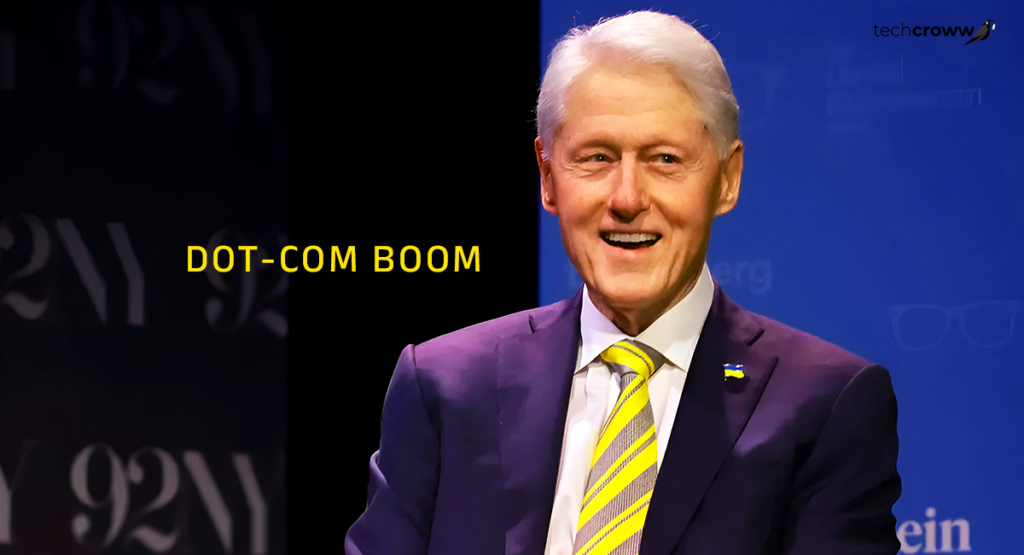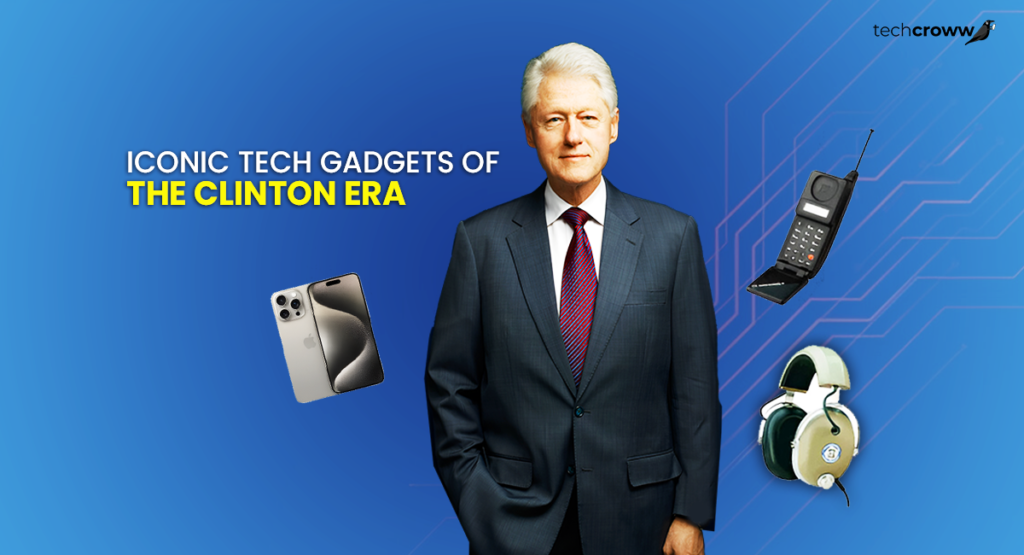Table of Contents
The 1990s changed technology in ways that heralded in the digital age, which has continued to transform our lives today. Leading this technological renaissance was President Bill Clinton facts, whose policies and initiatives helped greatly in causing innovation and increasing access to new technologies. Any insight into what Clinton did to affect technology is therefore in order for those who are tech enthusiasts and professionals; it helps get a feel for how all this began.
In this blog, we share how the Bill Clinton presidency whipped up many technological and techie gadget advancements, some of Bill Clinton facts, key policies, and landmark developments, and the lasting impact of the Clinton Administration on the United States technology industry. We’ll also share some really notable tech gadgets from the era that set up what’s possible now.
The Birth of the Digital Age under Bill Clinton
The period spanning 1993 to 2001 is recalled as the time when Bill Clinton was at the helm of the presidency, which was the time for rapid technological growth and innovation. Realizing the vast potential of technology in serving as a propeller of economic growth and quality of life, the Clinton administration had enacted some policies aimed at fostering the then-nascent technological industry.
Policies That Drove Technological Advancement
Telecommunications Act of 1996
- First major telecommunications law reform in over 60 years;
- Deregulation of the broadcasting and telecommunications markets;
- Encouraging competition, which will result in more innovative and less expensive services and products for consumers;
- Cleared the path for expanded Internet services and digital communication technologies.
Information Technology Agreement
- This was an international treaty negotiated under the auspices of the World Trade Organization in 1996;
- Eliminated tariffs on a broad range of IT products, thus promoting worldwide trade and accessibility.
- Opened foreign markets and slashed costs for U.S. tech companies.
- Increased the global diffusion of computers, semiconductors and telecommunication equipment.
Next Generation Internet Initiative
- Initiated to develop faster and more efficient internet infrastructure.
- Focused on increasing the speeds of the internet and fleshing out security in these networks.
- Resulting in huge research and development in networking technologies.
- Laid the foundation for the high speed internet services that we use today.
E-Government Initiatives
- Digitalization of Government Services and Increased Citizen Accessibility
- Online services for filing taxes, applying for benefits, and using public information portals were introduced to make the government more accessible to citizens.
- Increased efficiency and transparency in government.
- The practical use of emerging technologies in public administration was demonstrated.
The Dot-Com Boom: How Technology Meant Economic Prosperity

The Clinton era is often equated with the Dot-Com Boom—a period of the explosive growth of internet-based businesses and startups.
Factors that Contributed to the Dot-Com Boom
More Availability to Internet
- Adoption of personal computers and Internet access at reasonable prices.
- Explosive growth in Internet Service Providers and broadening of broadband infrastructure.
- Governmental efforts to introduce the Internet in schools and public institutions.
Investment by Venture Capital
- Exponential funding for start-ups working on new services and products for the Web.
- Many companies were born, which became a brand name in households like Amazon and eBay.
- Job creation and boost to economy through all walks of life. E-commerce Diffusion to Consumers
- Increasing confidence in e-commerce and digital transactions
- Creation of secure payment systems and smooth e-commerce portals
- Rearranging the very foundation of traditional retail models and consumer behavior.
Impact of Dot-Com Boom
Economic Growth
- Played significant roles in the U.S. GDP during the 1990’s
- Job creation ran into millions in the technology sector and related sectors.
- It wooed global talent for the country and established the U.S.’s lead in technology innovation.
Advancement in Technology
- Exponential growth in Web technologies, software applications, and digital services.
- Improvements in storage, processing, and the network.
- Core basis for future technological breakthroughs in many fields.
Challenges and Lessons Learned
- The eventual Dot-Com Bust underlined the risks of speculative investments and unsound business models.
- Brought wiser investment strategies and attention to profitability and long-term viability.
- Gave foresight for shaping future tech entrepreneurship and policy-making.
Iconic Tech Gadgets of the Clinton Era

The decade of the 1990s was a time for innovation in tech gadgets; several of these items were really groundbreakers and changed communication, work patterns, and ways of entertainment for most people.
Some Notable Tech Gadgets from 1990’s
IBM ThinkPad, 1992
- Among the very first really popular laptop computers.
- First use of new design elements like the TrackPoint navigation device.
- Brought portability and performance into business and personal computing.
Sony PlayStation (1994)
- Showcased advanced 3-D graphics and introduced immersive gaming.
- It expanded the videogame market and set new benchmarks in home entertainment.
- It positioned Sony as a leading corporation in the gaming industry.
Palm Pilot, 1996
- One of the first PDAs that included calendar, contact, and note applications.
- It gave a glimpse of the present-day smartphone because of its portability and intuitive usability.
- It was quite successful with the professional utilities for mobile tracking and handling of information.
Nokia 5110, 1998
- One of the most recognizable mobile phones, known for its durability and a potential for personalization of expression with interchangeable front covers.
- It made mobile communications more accessible through its ease of use and long battery life.
- It sported some of the most famous early games ever, like “Snake,” which added some fun value into mobile devices.
Apple iMac G3, 1998
- A revolutionary all-in-one desktop computer with a see-through plastic look differentiated it from others on the market.
- It emphasized ease of use and simplicity, making it appealing to the mass consumer market at large.
- Credited with Apple’s resurgence in the personal computer market under Steve Jobs’ leadership.
TiVo Digital Video Recorder, 1999
- It introduced time-shifting in television viewing by capturing live TV recordings.
- Permitted pausing, rewinding and fast-forwarding of programs, altering the habits of audiences.
- Led to the development of contemporary streaming services and video-on-demand.
Investments in R and D
- Increases in federal funding for scientific and technological research.
- Coordination between the government., universities, and private corporations.
- Encouragement of innovation, which resulted in quick advancements in consumer electronics.
Deregulation and Expansion of Markets
- Policies that ensured competition and decreased the barriers to technology companies.
- a favorable environment for start-ups and established firms to innovate
- Expanding domestic and international markets for U.S.-made tech products
Infrastructure Improvements
- Investment in telecommunications and internet infrastructure supports new technologies
- Stronger and enhanced connectivity that can power the development and adoption of internet-dependent devices
- Establishment of standards and protocols to allow interoperability and scalability
Long-term Impact on the Technology World Today

But the technological advances during Bill Clinton’s presidency are more than some would like to admit; in fact, most laid the foundation for many of the devices and services we use in current times.
Key Contributions to Modern Technology
Expansion of the Internet
- From Niche Network to Global Information Superhighway
- Social media, cloud computing, and e-commerce platforms
- Democratization of information access and communication channels
Advancements in Mobile Technology
- Early mobile phones and PDAs influenced today’s Smartphones and Tablets.
- Emphasis on portability and connectivity leading to continuous innovation
- Combining a number of functionalities into single, compact devices
Growth of the Software Industry
- Development of robust software ecosystems for supporting a range of applications
- User-friendly operating systems and interfaces developed
- Evolutionary growth in software development practices and methodologies
Innovation in Entertainment and Media
- Digitally driving a sea change in the ways of accessing and consuming games, music, and video.
- Establishing interactive and on-demand entertainment models
- Affecting content creation, distribution, and monetizing strategies.
- Clinton and the View of Technology Towards Society
Bridging of the Digital Divide
- Ensuring people have access to all sorts of technology, regardless of their socio-economic status.
- Programs targeted at assimilating technology into learning and public service for all.
- Realization of the potential power of technology in empowering individuals and economies.
Ethical and Responsible Use
- Initiatives taken in the form of privacy, security, and ethical thoughts in the use of technology.
- Debates on internet governance and digital rights
- There is a warrant on the balance between innovation and societal well-being and safety.
Conclusion
The Bill Clinton presidency was the defining epoch for technology in the United States. Filled with proactive policies and having a far-reaching, proactive approach toward the same, it imparted impetus to the unprecedented growth and innovation of the time. Much of the progress that occurred in this period has done a great deal to shape the modern tech landscape and the devices, services, and digital infrastructure through which we live our life every day.
For American readers, the interplay of leadership with technology that marked the Clinton years—supportive policies and investments in innovation and the impact on society—provides a primer for much that can be learned from this period. All through these, with the ever-changing digital world, the bases laid in this critical decade are testimonies to the power of transformation that a world possessing visionary governance and technological ingenuity can bring.


